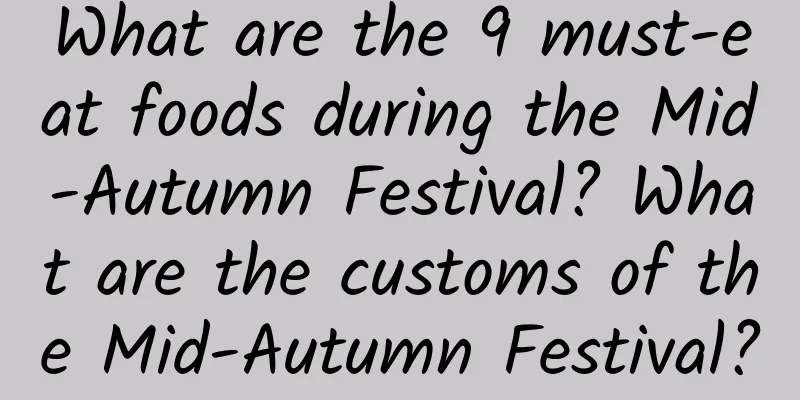What are the 9 must-eat foods during the Mid-Autumn Festival? What are the customs of the Mid-Autumn Festival?

|
Everyone must know about the Mid-Autumn Festival's Chang'e flying to the moon. In fact, there are two other mythological stories, namely Wu Gang picking laurel and Jade Rabbit pounding medicine. The mythological stories show the ancient Chinese people's innocent, simple, sincere and beautiful artistic imagination of the world, reflecting people's yearning and pursuit for a better life. It reflects the infinite charm of art. In addition to tasting mythological stories, eating moon cakes has become a necessary custom for celebrating the Mid-Autumn Festival in various parts of China. On this day of the Mid-Autumn Festival, people eat moon cakes to show "reunion". Moon cakes, also known as moon cakes, harvest cakes, palace cakes, reunion cakes, etc., are offerings to worship the moon god during the ancient Mid-Autumn Festival. There are also 9 must-eat foods. Let's take a look at what they are! Contents of this article 1. 9 must-eat foods during the Mid-Autumn Festival 2. What are the customs of Mid-Autumn Festival? 3. Three myths about the Mid-Autumn Festival 19 must-eat foods for Mid-Autumn FestivalThe nine must-eat foods during the Mid-Autumn Festival vary slightly from place to place. The most common ones are: osmanthus wine, grapefruit, hairy crabs, pomegranates, moon cakes, chestnuts, water chestnuts, snails, and taro. In addition, people in some regions will eat lotus roots, reunion steamed buns, glutinous rice cakes, pumpkins, Shandong wheat arrows, edamame, etc. during the Mid-Autumn Festival, and they will also drink osmanthus wine.The Mid-Autumn Festival, also known as the Moon Festival, Autumn Festival, Mid-Autumn Festival, Moonlight Festival, Moon Eve, Moon Worship Festival, Moon Niang Festival, Moon Festival, Reunion Festival, etc., is a traditional Chinese folk festival. On the day of Mid-Autumn Festival, there are folk customs such as worshiping the moon, appreciating the moon, eating moon cakes, playing with lanterns, appreciating osmanthus flowers, and drinking osmanthus wine. Mid-Autumn Festival is known as one of the four major traditional festivals in China, along with the Spring Festival, Qingming Festival, and Dragon Boat Festival. The Mid-Autumn Festival originated from the worship of celestial phenomena and evolved from the ancient autumn moon worship. The original "Moon Worship Festival" was the "Autumnal Equinox" in the 24 solar terms, and was later moved to the 15th day of the eighth lunar month. In some places, it is the 16th day of the eighth lunar month. 2What are the customs of Mid-Autumn Festival?The customs of the Mid-Autumn Festival include walking on the moon, offering sacrifices to the moon, appreciating the moon, begging for the moon, watching the tide, eating moon cakes, burning incense, lighting lanterns, guessing riddles, playing with rabbit gods, playing with lanterns, dancing with fire dragons, listening to incense, stealing moon vegetables, lighting pagoda lanterns, throwing handkerchiefs to invite spouses, stealing melons to pray for children, drinking osmanthus wine, stealing vegetables to ask for a husband, eating snails, and appreciating osmanthus flowers. In the Ming Dynasty, the Moon-Viewing Tower and the Moon-Playing Bridge were built in Nanjing. In the Qing Dynasty, there was a Moon-Facing Tower at the foot of Lion Rock. Both were popular places for tourists to "walk on the moon". Going out to enjoy the moon on Mid-Autumn Night is called "walking on the moon" by Shanghai people. Moon worship is a very old custom in my country. It is actually a kind of worship activity of the ancients to the "Moon God". In ancient times, there was a custom of "autumn dusk moon", which means worshiping the Moon God. Eating mooncakes has become an essential custom for the Mid-Autumn Festival in all parts of China. People eat mooncakes on this day to show "reunion". Mooncakes, also known as moon cakes, harvest cakes, palace cakes, reunion cakes, etc., were offerings to the moon god during the ancient Mid-Autumn Festival. 3Three myths about the Mid-Autumn FestivalThe three mythological stories of the Mid-Autumn Festival are Chang'e flying to the moon, Wu Gang picking laurels and the Jade Rabbit pounding medicine. Mythological stories are a kind of literary style created by ancient Chinese people through long-term social practice and in the process of working life. They are naive explanations of the universe, human origins, all things in nature, life exploration, tribal wars and working life through imagination in childhood.Chinese myths and legends show the innocent, simple, sincere and beautiful artistic imagination of the ancient Chinese people about the universe and everything in it, and reflect people's yearning and pursuit for a better life. Chinese myths are passed down orally among the people. Their magic and magnificence reflect infinite artistic charm. Chinese mythology has always been the earliest fantasy-form oral literary work of mankind. The ancient "Classic of Mountains and Seas" has many shadows of Chinese mythology. It is the earliest book in the world with written records of mythological stories. |
Recommend
How many days during ovulation will it take for the ovulation period to lead to pregnancy?
After getting married, having children becomes th...
Weekly Science | Eye Health Tips
1.Will people with myopia not suffer from presbyo...
Is there white tofu residue on a woman's private parts caused by bacteria?
There are more and more gynecological diseases in...
How can money and life be equal?
I was working the night shift in the anesthesia e...
There are several types of girls' personalities
Every girl has a different personality. Girls sho...
Causes and treatments of yellow lumps in vaginal discharge
Men are made of clay, women are made of who. Wome...
What can't you touch during menstruation?
In fact, there are many things that you are best ...
I feel sleepy, vomit and feel chest tightness five days after having sex.
If a woman feels sleepy, vomits, and has chest ti...
What are the treatments for inflammatory bowel disease (IBD)?
Inflammatory Bowel Disease (IBD) is a disease wit...
Fast breast enhancement essential oil method
There are many ways to enlarge breasts. Women oft...
How long to get pregnant after a miscarriage
There are two types of miscarriage: natural misca...
Do women have prostate glands?
The male prostate is a reproductive organ. We oft...
Pretty girls all have bad breath
Women care a lot about their appearance. They can...
Intermittent bleeding after 20 days of abortion
After a woman has an abortion, she will experienc...
The harm of irregular menstruation in girls
Women generally have their first menstruation bet...









